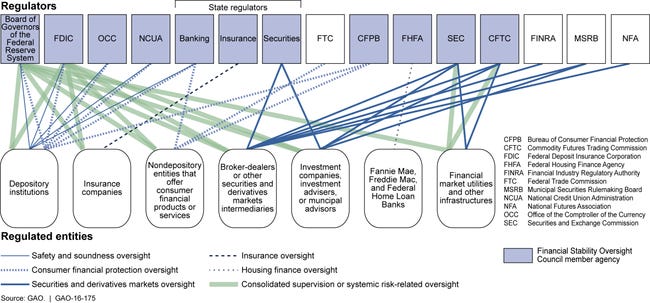President Trump’s Executive Order on Financial Regulation
If you haven’t read Hester’s piece on today’s Executive Order regarding Core Principles for Regulating the United States Financial System be sure you do so, this builds off of that.
Today’s order may seem like a minor thing, but there are some major implications to it. Here is my quick reaction to some of its provisions:
Section 1(a): empower Americans to make independent financial decisions and informed choices in the marketplace, save for retirement, and build individual wealth
This statement could be read to embrace an active role for regulators, but the role is to empower Americans to make their own choices. There is no indication that the Trump administration views its role as constraining people. Nor is there the focus on stability at all costs that arguably drove regulation since the crisis.
Section 1(c): foster economic growth and vibrant financial markets through more rigorous regulatory impact analysis that addresses systemic risk and market failures, such as moral hazard and information asymmetry
This may be the most interesting provision. It explicitly embraces regulatory impact analysis and highlights moral hazard, which is a pathology created/exacerbated by government backstopping of markets. This could mean that the Trump administration is going to take the risks posed to the markets by regulation seriously.
Section 1(d): enable American companies to be competitive with foreign firms in domestic and foreign markets
While I defer to my colleagues on matters of trade, this is interesting in that it anticipates robust domestic competition and foreign export of financial services. A hopeful sign.
Section 1(f)(apparently omitted from the website in a transcription error): Make regulation efficient, effective, and appropriately tailored.
This section may be, for my money, the most important. If taken seriously it would push regulators to regulate from a default of “yes” rather than “no”. It would also push them to create regulations that fit the nature and possibility of new financial innovations, rather than trying to cram them into an existing box. I’m not sure if anyone in the administration read my piece on how Trump can be a financial innovation President, but this provision is very much in that spirit.
(Of course, if section 1(f) was intentionally cut I will be sad)
Section 1(g): restore public accountability within Federal financial regulatory agencies and rationalize the Federal financial regulatory framework.
As Hester mentioned, this provision could indicate significant changes given how complex the federal regulatory environment is. Simplification and consolidation can help entrepreneurs better understand their regulatory picture, and may help encourage greater competition, entry, and dynamism in the market. This would benefit consumers.
It may also mean changing the structure of the CFPB to a bipartisan commission (as I have repeatedly advocated). Conversely it might mean that the Trump administration wants to go the other way and retain a sole director who serves at the President’s will. Either model would provide greater accountability than the status quo, though the Commission has other benefits that should be considered.
Section 2
Section 2 calls on the Treasury Secretary to consult with the heads of the various regulatory agencies and provide the President with periodic reports on how well the laws, regulations, guidance, etc. is promoting the order’s Core Principles, as well as identifying anything that inhibits them. This, if done well, could provide a needed top to bottom review of the regulatory environment, and hopefully allow for holistic review and reform. This could be a huge benefit to policy makers to help focus their efforts and hopefully create productive change that helps create an environment where Americans can thrive.





